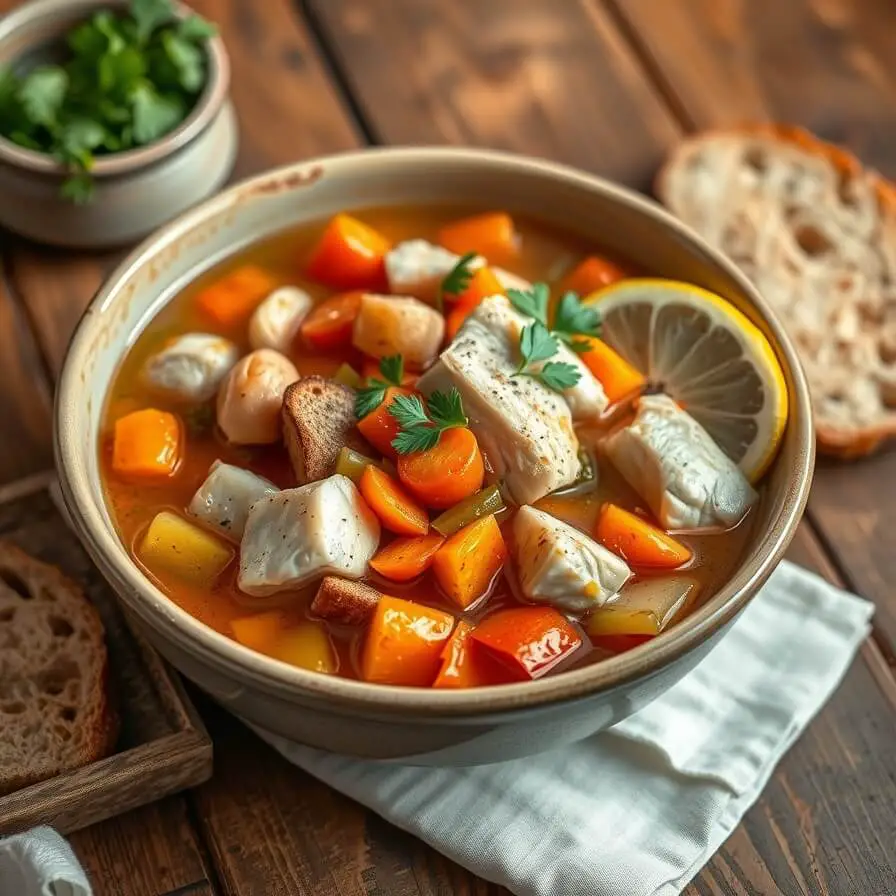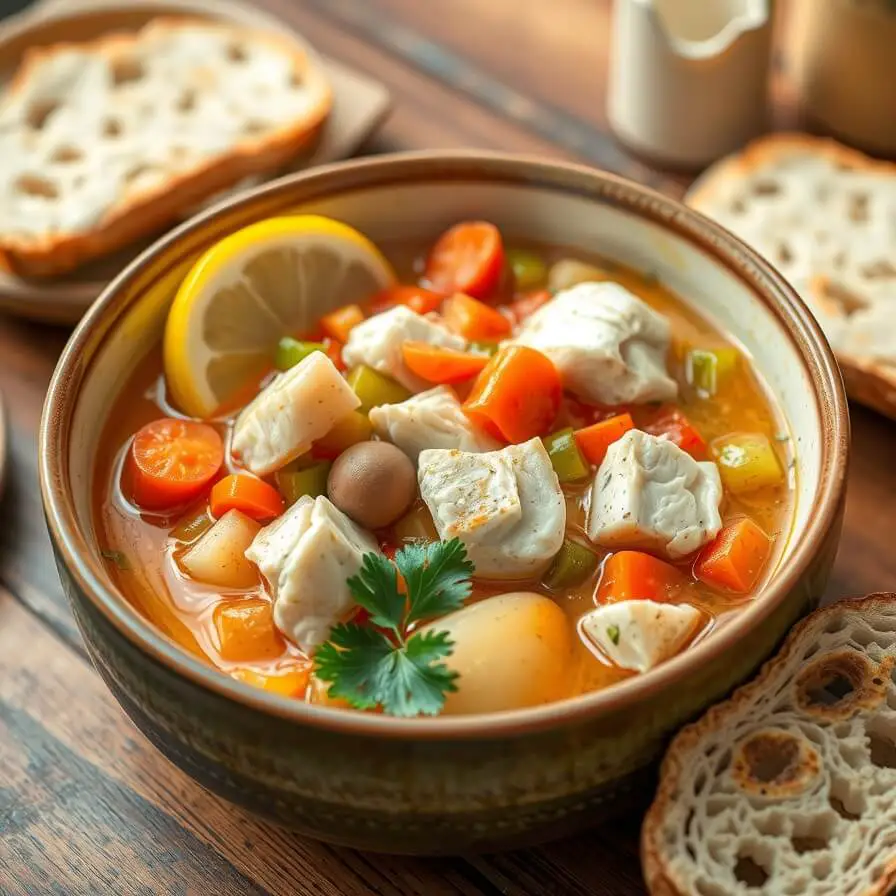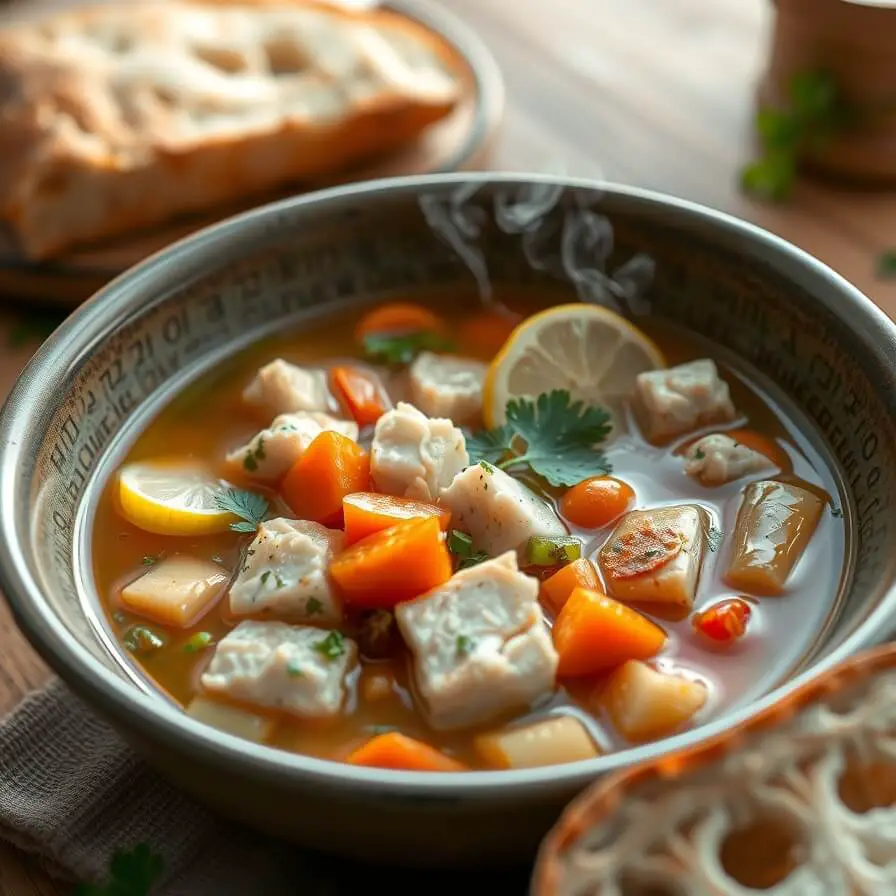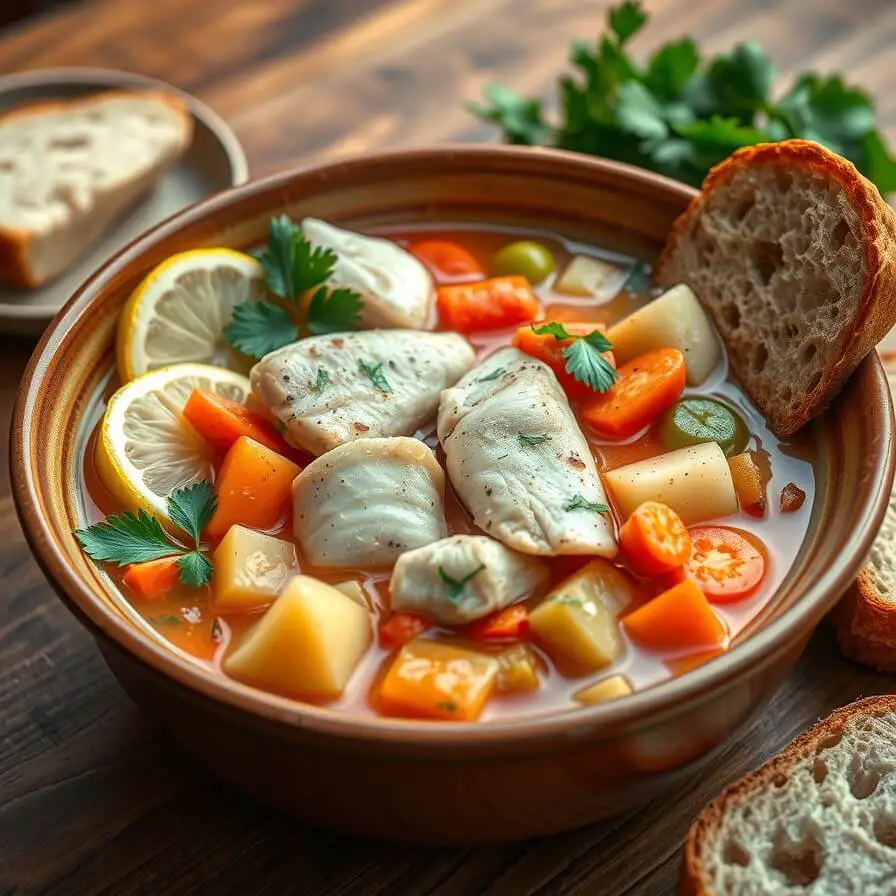Fish Stew Recipe

There’s something about the smell of simmering fish and herbs that instantly takes me back to my childhood. I remember the small coastal town where my grandparents lived, where the mornings were foggy, and the air smelled of salt and seaweed. My grandmother would come back from the fish market with a bounty of fresh catches and start preparing this simple yet heartwarming fish stew. The kitchen would fill with the aroma of garlic, onions, and a hint of lemon, drawing everyone in from their morning routines. I still remember my little cousin, impatiently hovering around the stove, eager to taste the first spoonful.
Making fish stew is more than just cooking; it’s about slowing down and savoring the flavors that come from fresh, wholesome ingredients. This particular recipe has been passed down and adapted over the years, keeping the soul of the original but adding a few modern twists. It’s perfect for a cozy family dinner, a weeknight comfort meal, or even impressing guests with a rustic yet refined dish.
Why I Love This Recipe
What makes this fish stew special is its delicate balance of flavors. Unlike some heavy seafood dishes, this stew is light yet rich, creamy but not overpowering, and infused with subtle aromatics that enhance rather than mask the freshness of the fish. Every spoonful is a harmonious blend of tender fish, sweet vegetables, and a savory broth that feels both comforting and elegant.
I love that it’s incredibly versatile. You can use white fish like cod or haddock, or mix in salmon for a richer taste. The herbs, garlic, and lemon add a freshness that cuts through the natural oiliness of some fish varieties, creating a lively, balanced flavor profile. And let’s not forget the vegetables—they add color, texture, and natural sweetness that makes each bite interesting.
Cooking this stew is a little ritual for me. From chopping fresh ingredients to simmering the broth and tasting along the way, it’s an experience rather than just a meal. Plus, it’s a dish that brings people together. The first time I served it to my friends, their eyes lit up, and the conversation slowed as we all savored it. It’s a stew that feels like a warm hug in a bowl.
Ingredients for Fish Stew
To make a delicious fish stew, you need fresh, high-quality ingredients, but nothing too complicated. Here’s what I usually gather before I start cooking:
- Fresh white fish fillets – I prefer cod or haddock because they hold together well during simmering. If you want richer flavor, a bit of salmon works beautifully.
- Onions and garlic – They form the aromatic base. I like to chop onions finely and crush garlic cloves to release their fragrance.
- Carrots and celery – They add sweetness and texture. Slice them thinly so they cook evenly.
- Bell peppers – Red or yellow for a pop of color and natural sweetness.
- Potatoes – Not too big, diced evenly; they give body to the stew and make it heartier.
- Tomatoes – Fresh or canned, for a slightly tangy depth.
- Fish or vegetable stock – This creates the light yet flavorful broth. Homemade stock is ideal, but store-bought works in a pinch.
- Herbs – Fresh parsley, thyme, and bay leaves. Fresh herbs make a noticeable difference; dried works if that’s all you have.
- Olive oil or butter – For sautéing the vegetables. I often use a mix for a richer flavor.
- Lemon juice – Adds brightness at the end. Don’t skip it—it really lifts the flavors.
- Salt and pepper – Season gradually and taste as you go.
These ingredients are flexible, and one of the joys of this recipe is that it adapts well to whatever vegetables or fish you have on hand. The key is to maintain balance—fresh fish, tender vegetables, and a flavorful broth.
How Much Time Will You Need?
This fish stew isn’t a quick five-minute recipe, but it’s not intimidating either. You’re looking at roughly:
- Prep time: 20–30 minutes for chopping vegetables, cleaning and cutting the fish, and gathering ingredients.
- Cook time: 30–40 minutes of simmering to meld flavors and cook the fish to perfection.
- Total time: About 1 hour from start to finish, depending on your pace in the kitchen.
It’s perfect for a weekend lunch or a relaxed dinner when you can take your time. And honestly, the aroma while it simmers is worth every minute.
How to Make This Fish Stew

Step-by-step, here’s how I bring this stew to life:
Step 1: Prepare the vegetables
Start by peeling and slicing your onions, carrots, and potatoes. Dice the bell peppers and crush the garlic cloves. Keep everything organized because once the cooking starts, things move quickly.
Step 2: Sauté the aromatics
In a large, heavy-bottomed pot, heat olive oil and butter over medium heat. Add onions and garlic first, stirring until translucent and fragrant—about 3–5 minutes. Then toss in carrots, celery, and bell peppers, letting them soften slightly while stirring occasionally.
Step 3: Add the potatoes and tomatoes
Once the vegetables are lightly softened, add the diced potatoes and tomatoes. Stir to coat them in the fragrant oil and butter. The tomatoes will start releasing their juice, which forms the base of your broth.
Step 4: Pour in the stock and herbs
Add enough fish or vegetable stock to just cover the vegetables. Toss in a bay leaf, a few sprigs of thyme, and a handful of parsley. Bring everything to a gentle boil, then reduce heat and simmer for about 20 minutes until potatoes are tender.
Step 5: Cook the fish
Cut your fish into even, bite-sized pieces. Gently nestle them into the simmering broth. Cover and cook for 8–10 minutes, depending on the thickness of your fish, until it flakes easily with a fork. Avoid over-stirring to prevent the fish from breaking apart.
Step 6: Season and finish
Taste the stew and adjust with salt and pepper. Squeeze in fresh lemon juice for brightness and a touch of acidity. Remove bay leaves and thyme stems before serving.
Substitutions
Fish stew is incredibly forgiving if you need to make adjustments:
- If you can’t find fresh fish, frozen works well; just thaw it completely before cooking.
- For a creamier stew, stir in a splash of coconut milk or heavy cream at the end.
- Don’t have potatoes? Sweet potatoes or parsnips add sweetness and body.
- Swap herbs based on what’s fresh or available—dill or tarragon adds a lovely variation.
- Can’t do bell peppers? Zucchini or fennel can provide similar texture and flavor.
These small tweaks can make the stew suit your pantry and taste preferences perfectly.
Best Side Dishes for Fish Stew
Pairing is key to a great meal. I love serving this fish stew with:
- Crusty bread – Perfect for soaking up the flavorful broth.
- Garlic butter rice – Adds a comforting, hearty element that complements the fish.
- Light salad – A simple green salad with a lemon vinaigrette brightens the plate and balances richness.
These sides round out the meal without overpowering the delicate flavors of the stew.
Serving and Presentation Tips
There’s something almost magical about presenting fish stew in a way that feels inviting without fuss. I like to serve it in wide, shallow bowls so every piece of fish and vegetable is visible. A sprinkle of fresh parsley or dill right before serving adds a pop of color and a fresh aroma that makes the dish feel alive.
If you’re feeling fancy, a small drizzle of high-quality olive oil or a squeeze of lemon on top gives the stew a glossy finish and brightens the flavors. I also love to place the bowl on a wooden board with a slice of crusty bread on the side—it gives a rustic, homey vibe that instantly makes the meal feel special.
For a casual family dinner, I sometimes let everyone serve themselves from the pot at the center of the table. There’s something comforting about the stew bubbling gently while everyone ladles their own portions. Presentation doesn’t have to be complicated; it’s all about warmth, color, and inviting aroma.
Tips and Tricks to Make This Recipe Even Better

Making a great fish stew is all about layering flavors and knowing a few tricks that elevate it:
- Use fresh fish whenever possible – The freshness of your fish is the foundation of the dish. If you must use frozen, thaw it slowly in the fridge to preserve texture.
- Don’t rush the simmering – Allowing the vegetables and stock to simmer slowly helps the flavors meld beautifully. A slow simmer is worth the extra 10–15 minutes.
- Add herbs at the right time – Fresh herbs added at the end maintain their fragrance, while dried herbs or tougher stems are best added at the beginning of simmering.
- Taste as you go – Season gradually with salt, pepper, and lemon juice. Fish stew is delicate; a little seasoning at the end can make a big difference.
- Gentle stirring for fish – Once the fish is in, stir minimally to avoid breaking the fillets. Let them cook gently in the broth for perfect texture.
These little tricks make the difference between a good stew and a memorable one.
Common Mistakes to Avoid
Even seasoned cooks make mistakes with fish stew. Here’s what to watch out for:
- Overcooking the fish – Fish cooks quickly, and overcooked fish becomes rubbery and falls apart. Keep a close eye once it’s in the pot.
- Undercooked potatoes – Make sure the potatoes are tender before adding the fish; they need more cooking time than the fish.
- Too much stirring – Stirring aggressively once the fish is added can ruin the texture. Gently fold the fish in instead.
- Skipping seasoning at the end – Lemon juice and salt added at the last minute lift the flavors; don’t forget this step.
- Using weak stock – A bland broth will make the stew taste flat. Use a flavorful stock or enhance it with aromatics and herbs.
Avoiding these mistakes ensures your stew is perfectly balanced and delicious every time.
How to Store It
If you have leftovers (though unlikely!), storing fish stew properly helps retain its flavor:
- Refrigeration – Let the stew cool completely, then store in an airtight container for up to 2 days. Fish is delicate, so don’t keep it longer.
- Freezing – While possible, freezing may alter the texture of the fish slightly. If you must, freeze without potatoes and add them fresh when reheating. Use freezer-safe containers for up to 1 month.
- Reheating – Reheat gently on the stove over low heat. Avoid microwaving for long periods, as this can overcook the fish.
Proper storage keeps your stew tasting fresh and delicious even the next day.
FAQ
Can I use other types of fish in this stew?
Yes! White fish like cod, haddock, tilapia, or even salmon work well. Avoid very oily or strong-tasting fish that might overpower the broth.
Can I make this stew creamy?
Absolutely. Add a splash of coconut milk or cream at the end of cooking for a richer, velvety texture.
Is this stew gluten-free?
Yes! All ingredients are naturally gluten-free. Just double-check any store-bought stock to be sure.
Can I make this stew spicy?
Yes, add a pinch of red chili flakes or a chopped fresh chili when sautéing the vegetables for a gentle heat.
What can I serve with this stew?
Crusty bread, garlic butter rice, or a simple green salad are my top three favorites. They complement the stew without overpowering it.

Fish Stew Recipe
- Total Time: 1 hour
- Yield: 4–6
- Diet: Gluten Free
Description
This fish stew is a heartwarming blend of fresh fish, tender vegetables, and a fragrant broth. Perfect for family dinners or cozy evenings, it’s light yet rich and bursting with flavor. Fresh herbs, lemon, and a touch of butter make it feel special, while simple ingredients keep it approachable. Whether you serve it with crusty bread or a fresh salad, this stew is sure to become a favorite in your kitchen.
Ingredients
- 1 lb fresh white fish fillets (cod, haddock, or salmon), cut into chunks
- 2 tablespoons olive oil
- 1 tablespoon butter
- 1 medium onion, finely chopped
- 3 garlic cloves, crushed
- 2 carrots, sliced
- 2 celery stalks, sliced
- 1 bell pepper, diced
- 2 medium potatoes, diced
- 2 tomatoes, diced or 1 cup canned tomatoes
- 4 cups fish or vegetable stock
- 1 bay leaf
- 2–3 sprigs thyme
- 1 handful fresh parsley, chopped
- Juice of 1 lemon
- Salt and pepper, to taste
Instructions
- Heat olive oil and butter in a large pot over medium heat. Sauté onions and garlic until translucent.
- Add carrots, celery, and bell peppers, cooking until softened.
- Stir in potatoes and tomatoes, then pour in stock. Add bay leaf and thyme, bring to a gentle boil, then reduce heat to simmer 20 minutes.
- Gently add fish chunks, cover, and simmer 8–10 minutes until fish is cooked through.
- Season with salt, pepper, and lemon juice. Remove herbs before serving.
Notes
- Use fresh fish for best results.
- Taste and adjust seasoning at the end.
- Serve with crusty bread, garlic butter rice, or a light salad.
- Prep Time: 25 minutes
- Cook Time: 35 minutes
- Category: Main Dish
- Method: Simmering
- Cuisine: Coastal European-inspired
Nutrition
- Serving Size: 4–6
- Calories: 280
- Sugar: 5g
- Sodium: 600mg
- Fat: 10g
- Saturated Fat: 3g
- Unsaturated Fat: 7g
- Trans Fat: 0g
- Carbohydrates: 20g
- Fiber: 4g
- Protein: 30g
- Cholesterol: 55mg







